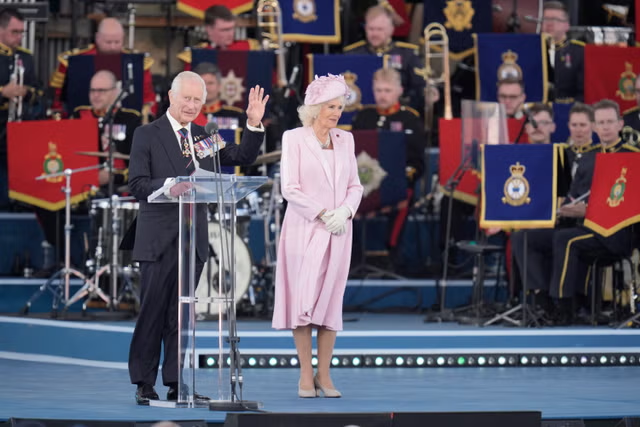At dawn on June 6 1944, 20-year-old John Roberts was serving as a sub-lieutenant on the bridge of HMS Serapis. The British destroyer had successfully crossed the heavily mined Channel as part of the largest seaborne invasion in history when a German ship torpedoed a nearby Allied vessel.
“The ship was only 500 yards away and there was a tremendous blast. Everybody on board Serapis grabbed hold of something to steady themselves from the shock wave,” recalls Roberts. “Svenner broke in two and sank very quickly. We weren’t allowed to stop and pick up the survivors.”
Serapis sailed on to support the landings on Sword Beach, peppering the coastline near Caen for days with four 4.7-inch guns. “I remember the entire beach was on fire from RAF bombing before the ground attack – it was a devastating sight.”
Not surprisingly, those memories of D-Day have never faded for Roberts, who lives by the sea in Whitstable, Kent. Surviving hostilities, he later captained the aircraft carrier Ark Royal and eventually rose to the rank of rear admiral.
Despite celebrating his 100th birthday in April, he still enjoys driving and has much happier memories of his motoring exploits during wartime Britain.
“They were very different times, not just because of the constraints of the war itself. Cars were more rudimentary, much slower and had none of the modern comforts we are used to today. A manual window winder was a luxury, even a heater was only fitted at extra cost.”
Roberts, who grew up in north Wales, learnt to drive in his father’s car on Black Rock Sands, near Porthmadog. “I was 11 in 1935. The sand was very hard and, in those days, it was common for youngsters to have a go behind the wheel. I had to master double declutching at a time when synchromesh [in the gearbox] was a rarity. Everybody crunched the gears.”
After joining Dartmouth Naval College as a 13-year-old cadet, Roberts bought a BSA 250 motorbike on his 16th birthday. “Motorbikes were a rite of passage for many young men, a cheap and essential form of transport rather than a weekend hobby,” he says.
“The war had started seven months earlier in September 1939 and car manufacturers would soon be required to switch production and supply vehicles to the military effort. Buying a car would become near impossible for the average man in the street.”
Roberts served on the battlecruiser Renown in the North Atlantic and the destroyer Tartar in the Mediterranean, before joining the crew of Serapis in 1943. One reason why a private car was scarce was petrol rationing, which Roberts remembers well. “Because I was in the Navy, I was given a fuel allowance for my Rover, but that was barely enough. I was part of the fleet at Scapa Flow in the Orkney Islands and that required an epic trip by road to the very north of Scotland.”
In a cunning plan designed to save some of his petrol allowance for pleasure use, Roberts and his Navy chums would add gallons of paint thinners to the tank to dilute the petrol. Tyres were also difficult to buy and one wartime journey in particular proved unforgettable, for all the wrong reasons.
“When I left Scotland, I could already see the inner tube poking through the remaining rubber on one tyre. It then took me 13 hours to drive home to north Wales at 50mph. Back then, drivers knew how to repair a puncture themselves but a recycled, retreaded tyre was usually the only replacement available.”
As fuel dried up and spare parts disappeared, many motorists were forced to leave their vehicles in the garage. Roberts says some of his colleagues would park next to another officer’s vehicle and syphon fuel directly from one tank to the other, in the dead of the night. “People were very resourceful!”
Roberts’s first car just after the war ended was a pale blue Lagonda Rapier purchased for only £150. “By then I had joined the Fleet Air Arm as a pilot. I bought it from a colleague on my flying course who needed the money to buy an engagement ring,” says Roberts. “I must have done him a favour because he later married the girl, but imagine owning a Lagonda for that sort of money now!”
The 1.1-litre tourer dated back to the mid-1930s but Roberts’s particular car suffered with a slipping clutch. He later sold it to a colleague and in 1946 purchased a Lagonda 2-Litre from a garage owner in Cornwall. “PK 9203 was an absolute beauty in British racing green and, unknown to me at the time, had raced at Le Mans in 1929. Unfortunately, I damaged the engine by adding the wrong oil.”
Without a heater, Roberts would drive top down, wrapped in a sheepskin flying jacket against the bitter British weather. Often alongside him in the passenger seat was his friend John Williams-Ellis, the nephew of Sir Clough Williams-Ellis, who designed Portmeirion village in Wales, and the father of David, who sculpted the D-Day memorial in Normandy.
His final Lagonda was a 4.5-litre M45, which he sold in 1955. “I’ve owned many cars since then and enjoyed driving for work and pleasure. One notable moment was in 1959, when the M1 motorway first opened. People were genuinely scared by a three-lane road, but I thought it was wonderful to have no speed limit.”
Today, Roberts owns a more sedate Kia Carens people carrier, which he says is a world away from his first car. “I never sat a driving test, because of an exemption during the war. Cars are so sophisticated now they virtually drive themselves, which I know is coming too.”
Aston Martin bought his beloved Lagonda marque in 1947 and, for now, it remains a dormant part of the Gaydon-based brand. So, to celebrate his centenary, we took Roberts for a drive in Aston’s flagship DB12 tourer.
His verdict: “It’s not as roomy as I thought, but I’m more than willing to swap for my Kia.”
Disclaimer: The copyright of this article belongs to the original author. Reposting this article is solely for the purpose of information dissemination and does not constitute any investment advice. If there is any infringement, please contact us immediately. We will make corrections or deletions as necessary. Thank you.



